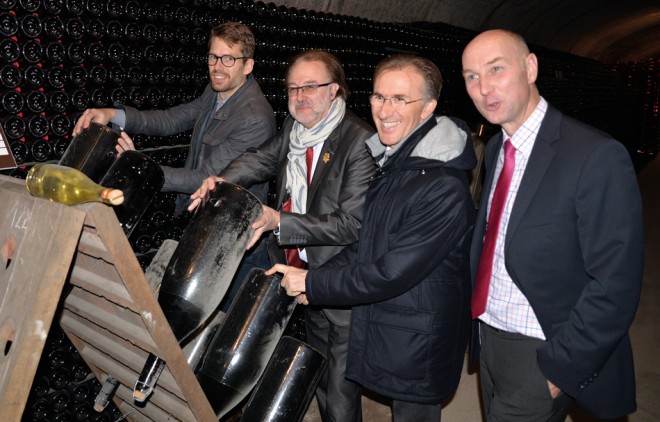If you ever wondered what the ‘J’ in “J de Telmont” stood for, stop wondering. It does not stand for anything. Telmont is not the winemakers’s last name, and the J is not his first initial. It is a made-up name, that André Lhopital, son of Henry, the founder of the domain, came up with in the 1950’s.

André thought the name ‘Lhopital’ unadapted to the commercialization of fine wines, and went about creating his own brand name. You could say he was a bit of a visionary since he understood the importance of ‘brand identity’ ealier than most… Starting with the name “Les Beaumonts”, from the name of a local plot, it took him three years and a lot of changes to obtain the CIVC’s seal of approval and settle on the current brand name “J de Telmont”.
Today the domain, located in the town of Dammery, in the heart of the Marne Valley, is run by André’s grandchildren, Bertrand and Pascale Lhopital, who have taken over from his son Serge.
For SommelierS International, three World Best Sommeliers have agreed to come and visit the domain: Philippe Faure Brac, winner in 1992, Paolo Basso, crowned in 2013, and Arvid Rosengren, title holder since april 2016. For them, Bertrand has prepared a vertical tasting of the “O.R. 1735” cuvée, with the 2004, 2001 and 2000 vintages, as well as “Grand Couronnement 1998”.
The “O.R. 1735” name refers to the 1735 French royal decree authorizing the bottling of wine, and therefore of Champagne, and considered to be its official birthdate. It is J de Telmont’s prestige cuvée. It is a 100% Chardonnay wine, made exclusively from Grand Crus, vinified in stainless steel and oak barrels, aged for ten years minimum in a corked bottled, and with a dosage of 4.5 gr/l.
Philippe Faure-Brac enjoys the “toasted notes of the 2004, even though they tend to fade in mid-palate, and though the oakiness is a bit overly present”. He stresses that the “2001 is balanced and very long. It displays nice roundness and a little toastiness as well, probably due to its oak vinification. The wine is quite balanced and, on the palate, its texture is quite homogenous displaying notes of dry currants”. He finds the 2000 vintage to be a bit off, whereas the Grand Couronnement 1998, which is also a 100% Chardonnay, is “ravishing”. “It is a classic, Philippe says, fruity, elegant, with pastry notes, harmonious on the palate with a nice long and fresh finish.”
For Paolo Basso, the “O.R. 1735” vintage 2001 is a “refined and complex wine with nice maturities, notes of spices and underbrush, a very nice nose, quite classy, and on the palate softness and roundness, a savory and saline side, with a delicate and fine finish. A very seductive wine”.
His personal favorite however is also the Grand Couronnement 1998. He particularly enjoys its “nose with its notes of yeast, green pepper and soot, as well as its complexity and freshness on the palate. The delicate finish and ample minerality make it an outstanding wine”.
Arvid’s own preference goes to the 2004, over the other two vintages. “The 2004 vintage can go a very long way. In my view, he says, it is superior to the other two.” Still the 2001 had its charms. “I like its aromas, it reminded me of great white Burgundies. It is delicious and should be enjoyed now.” He adds “the 2000 could still hold its ground, but the 2001 possesses that extra note of freshness that made it more enjoyable”.
For a final touch, Bertrand suggested something slightly off the beaten track, and opened an (unclaimed) 2010 100% Chardonnay with zero sulfites and produced in biodynamics. The wine, he concedes, is “a bit disconcerting”. 2010 was a difficult year. September lacked sunshine. “Biodynamics force us to relearn our oenology. We have to regain the commonsense approach of our ancestors.”
Gérald Olivier